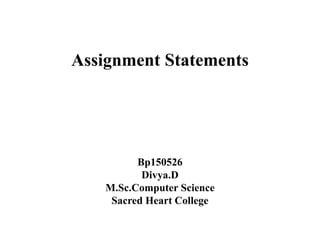
Assignment statements
- 1. Assignment Statements Bp150526 Divya.D M.Sc.Computer Science Sacred Heart College
- 2. Topics • Names in the symbol table • Reusing temporary names • Addressing array elements • The translation scheme for addressing array elements. • Accessing fields in records
- 3. Names in the Symbol table • Emit (instruction): emit a three address statement to the output • newtemp: return a new temporary • lookup(identifier): check if the identifier is in the symbol table. • Grammar: S->id:=E E->E1+E2 E->E1*E2 E->-E E->(E1) E->id
- 4. Translation scheme to produce three address code for assignment statement S->id:=E {p:=lookup(id.name); if (p!=nil) then emit(p ‘:=‘ E.place); else error} E->E1+E2 {E.place = newtemp; emit(E.place ‘:=‘ E1.place ‘+’ E2.place);} E->E1*E2 {E.place = newtemp; emit(E.place ‘:=‘ E1.place ‘*’ E2.place);} E->-E1 {E.place = newtemp; emit(E.place ‘:=‘ ‘-’ E1.place);} E->(E1) {E.place = E1.place;} E->id {p = lookup(id.name); if (p!= nil) then E.place := p; else error;}
- 5. Reusing temporary names – The code generated by E->E1+E2 has the general form: Evaluate E1 into t1 Evaluate E2 into t2 t3 := t1 + t2 » All temporaries used in E1 are dead after t1 is evaluated » All temporaries used in E2 are dead after t2 is evaluated » T1 and t2 are dead after t3 is assigned – Temporaries can be managed as a stack: » Keep a counter c, newtemp increases c, when a temporary is used, decreases c. » See the previous example.
- 6. Addressing array elements – Arrays are typically stored in block of consecutive locations. – One-dimensional arrays • A: array[low..high] of … • the ith elements is at: base + (i-low)*width i*width + (base – low*width) – Multi-dimensional arrays: • Row major or column major forms – Row major: a[1,1], a[1,2], a[1,3], a[2,1], a[2,2], a[2,3] – Column major: a[1,1], a[2,1], a[1, 2], a[2, 2],a[1, 3],a[2,3] • In raw major form, the address of a[i1, i2] is Base+((i1-low1)*(high2-low2+1)+i2-low2)*width
- 7. Addressing array elements • In raw major form, the address of a[i1, i2] is Base+((i1-low1)*(high2-low2+1)+i2-low2)*width
- 8. – In general, for any dimensional array, the address of a[i1, i2, i3, …, ik] can be computed as follows: • Let highj and lowj be for bounds for ij • Let nj = highj – lowj + 1 • The address is • ((…(i1*n2+i2)*n3+…)nk+ik)*width + base – ((…low1*n2+low2)*n3+…)nk+lowk) * width – When generating code for array references, we need to explicitly compute the address.
- 9. Translation scheme for array elements • Limit(array, j) returns nj=highj-lowj+1 • .place: the temporarys or variables • .offset: offset from the base, null if not an array reference • Grammar: S->L := E E->E+E E->(E) E->L L->Elist ] L->id Elist->Elist, E Elist->id[E
- 10. S->L := E { if L.offset = null then emit(L.place ‘:=‘ E.place) else emit(L.place’[‘L.offset ‘]’ ‘:=‘ E.place);} E->E1+E2 {E.place := newtemp; emit(E.place ‘:=‘ E1.place ‘+’ E2.place);} E->(E1) {E.place := E1.place;} E->L {if L.offset = null then E.place = L.place else {E.place = newtemp; emit(E.place ‘:=‘ L.place ‘[‘ L.offset ‘]’); } } L->Elist ] {L.place = newtemp; L.offset = newtemp; emit(L.place ‘:=‘ c(Elist.array)); emit(L.offset ‘:=‘ Elist.place ‘*’ width(Elist.array); }
- 11. L->id {L.place = lookup(id.name); L.offset = null; } Elist->Elist1, E { t := newtemp; m := Elist1.ndim + 1; emit(t ‘:=‘ Elist1.place ‘*’limit(Elist1.array, m)); emit(t, ‘:=‘ t ‘+’ E.place); Elist.array = Elist1.array; Elist.place := t; Elist.ndim := m; } Elist->id[E {Elist.array := lookup(id.name); Elist.place := E.place Elist.ndim := 1; }
- 12. E.place := newtemp; if E1.type = integer and E2.type = integer then begin emit(E.place’:=’E1.place ’int+’E2.place); E.type: = integer end else if E1.type = real and E2.type = real then begin emit (E.place ’:=’E1.place ‟real +‟ E2.place); E.type := real end else if E1.type = integer and E2.type = real then begin u := newtemp; emit(u ’:=’‟inttoreal‟ E1.place); emit(E.place ’:=’u ‟real+‟ E2.place); E.type:= real end else if E1.type = real and E2.type = integer then begin u := newtemp; emit(u ’:=’‟inttoreal‟ E2.place); emit(E.place ’:=’E1.place ‟real+‟ u); E.type: = real end else E.type:= type error; Fig. 8.19. Semantic action for E E1 + E2. Type conversions with Assignments
- 13. Cont… • The semantic action of Fig. 8. l9 uses two attributes E.place and E.type for the non-terminal E. • As the number of types subject to conversion increases. • The number of cases that arise increases quadratically (or worse, if there are operators with more than two arguments). • Therefore with large numbers of types, careful organization of the semantic actions becomes more important.
- 14. Accessing Fields in Records • The compiler must keep track of both the types and relative addresses of the fields of a record. • An advantage of keeping this information in symbol-table entries for the field names is that the routine for looking up names in the symbol table can also be used for field names. T record L D end {T.type := record(top(tblptr)); T.width := top(offset); Pop(tblptr); pop(offset) } L ε { t:= mktable(nil); Push(t, tblptr); push (0, offset) }
- 15. Cont… • lf r is a pointer to the symbol table for a record type, then the type record(t) formed by applying the constructor record to the pointer was returned as T.type We use the expression , p↑.info + 1 • From the operations in this expression it follows that p must be a pointer to a record with a field name info whose type is arithmetic.
- 16. Cont…. pointer (record(t)) • The type of pt is then record(t), from which t can be extracted. The field name info is looked up in the symbol table pointed to by t.
- 17. ?